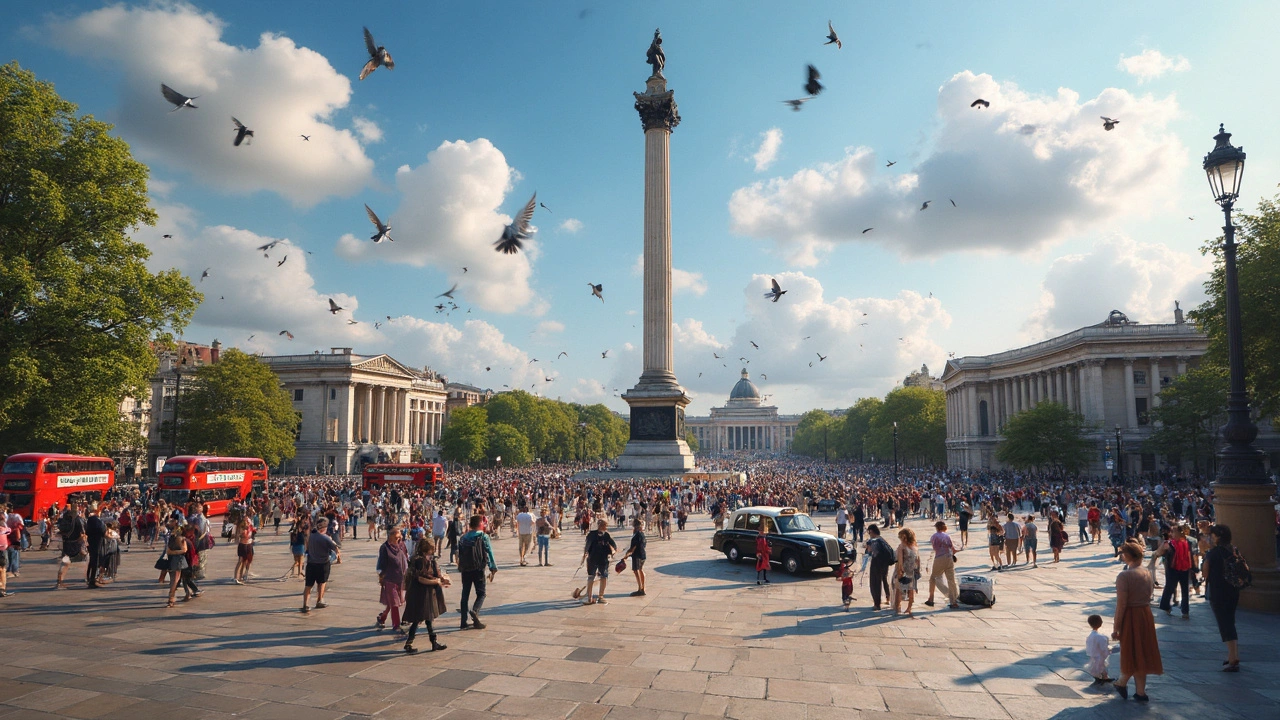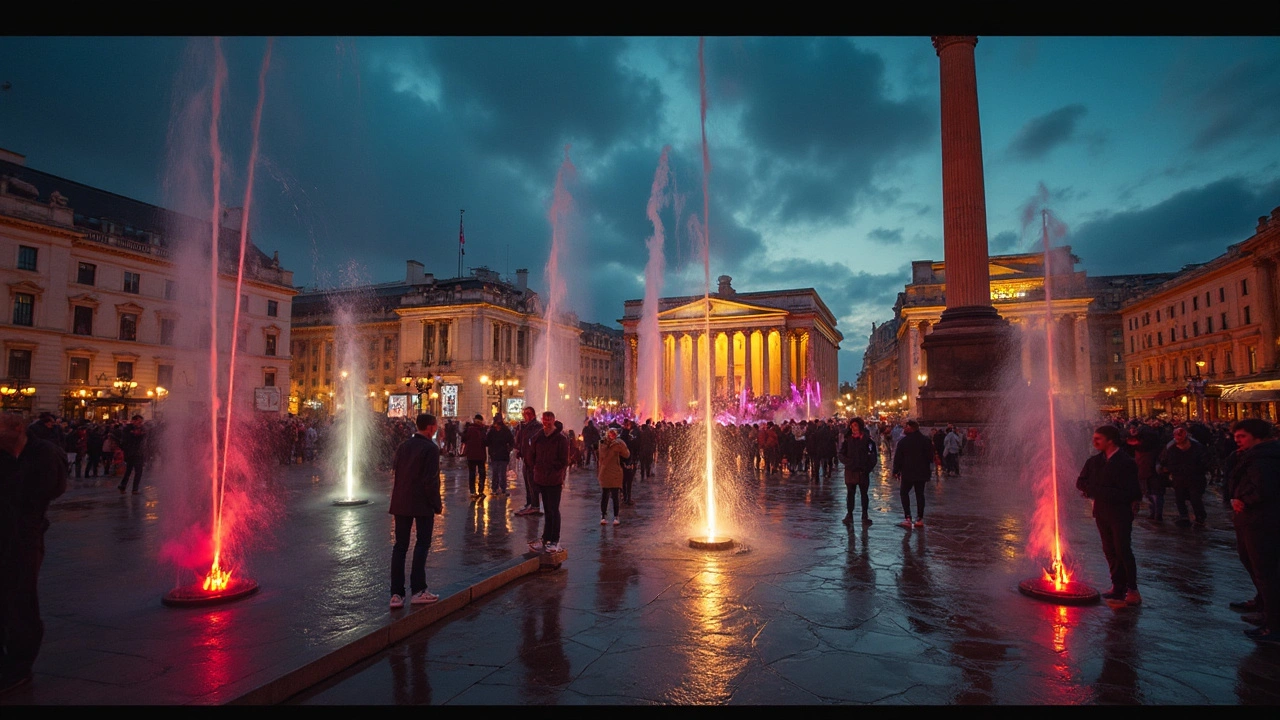Trafalgar Square in London: More Than a Landmark

There’s nowhere in London quite like Trafalgar Square. You’ll spot red double-deckers whizzing past, street artists chalking masterpieces, and crowds melting into one another—all in one open space. This spot isn’t just a backdrop for photos; it’s where London lives out some of its biggest moments. If you wanted to catch the city’s mood—be it joy, outrage, or just everyday hustle—Trafalgar Square is the place to look.
Even if you don’t spend much time in Central London, you’ve likely ended up here at least once—maybe waving a flag or meeting friends near the lions. The National Gallery looms overhead, promising free culture just steps away. You’ll hear buskers and see spontaneous events from Diwali lights to New Year’s fireworks. For anyone living or working nearby, the square doubles as an unofficial meeting zone. Knowing where to cut across during rush hour (Coventry Street saves precious minutes) or which corner is best for people watching, is almost a local rite of passage.
- A Pulse Point in London Life
- Art, Statues, and Symbols
- Gatherings, Protests, and Festivals
- Insider Tips and Hidden Corners
A Pulse Point in London Life
Trafalgar Square isn’t your regular city plaza. It’s where London’s heartbeat gets loudest—sometimes in celebration, sometimes in protest, and often just in daily city rhythm. Every year, more than 15 million people walk across its paving stones. Whether you’re grabbing a Pret sandwich for lunch or running for a bus at Charing Cross, the Square somehow ends up on your path.
It’s seen royal events like the Queen’s Jubilee and huge crowds on New Year’s Eve. When England’s football team makes it far in the Euros or World Cup, giant screens and chanting crowds fill the space. During big protests, from anti-Brexit marches to climate rallies, this is ground zero. You’ll also find the Christmas tree donated each December from Oslo—a tradition since 1947, as a thank you for British help during World War II. The lighting ceremony draws thousands and marks the start of the London Christmas season for loads of families.
If you check Transport for London stats, Charing Cross Tube is in the top fifteen busiest stations, mostly due to people heading for Trafalgar Square. Local coffee shops—especially Notes and Caffè Nero just around the corner—see endless streams of commuters, tourists, and museum goers. The whole area acts as an unofficial crossroads: head north to Leicester Square, south for Embankment, east to Covent Garden, or west toward Soho. No other square offers this same mix of connection and chaos.
| Year | Major Trafalgar Square Event | Estimated Attendance |
|---|---|---|
| 2012 | Olympic victory parade | 500,000 |
| 2018 | Football World Cup screenings | 60,000+ |
| 2023 | Pride in London rally | 200,000 |
Why does all this matter? Because unlike other London attractions, Trafalgar Square really is for everyone. It’s both a landmark and a living, changing symbol of the city’s energy. Once you know how to navigate it, you start noticing new things—a flash mob, a guerrilla art installation, or just a particularly dramatic pigeon chase. It’s London, unfiltered.
Art, Statues, and Symbols
The giant lions at Trafalgar Square get all the attention, but there’s way more going on in terms of public art. Right in the middle stands Nelson’s Column, built in 1843 as a tribute to Admiral Nelson and his victory at the Battle of Trafalgar. It’s the most famous part of the square and honestly, you can’t walk through here without someone trying (and failing) to climb up for a photo with it.
Walk around and you’ll spot four plinths at the corners. Three of them have classic statues—King George IV, General Havelock, and General Napier, all with that old-school heroic look. The fourth, though, is where things get seriously interesting. Known as the Fourth Plinth, this spot is a rotating showcase for modern art that’s sparked everything from debates to Instagram frenzies. Past pieces include a giant blue cockerel, a huge hand with a thumbs-up, and even ice cream with a cherry on top and drones buzzing around it. Each piece usually stays for a year or two, so locals keep coming back to see what pops up next.
Right next door, the National Gallery holds one of Europe’s best collections, and it’s free entry. So after checking out the lions, you can see real Monets and Van Goghs in five minutes' walk. Don’t skip the fountains—installed in 1845, but revamped with fancy new pumps to keep the water clean (and safe for those regular fountain-jumping dares in summer).
If you want a quick look at what’s around, check out this at-a-glance table:
| Artwork | Location in Square | Fun Fact |
|---|---|---|
| Nelson's Column | Centre | 52m tall, lion statues added in 1867 |
| Fourth Plinth | NW corner | Hosts new art every 1–2 years |
| King George IV | NE corner | Was meant for Buckingham Palace |
| General Havelock | SE corner | Controversial colonial figure |
| General Napier | SW corner | Unveiled in 1855 |
If you come early in the morning, the place is mostly empty. That’s the best time to see the statues up close—without dodging skateboarders or crowds. And if you’re into photography, local advice says sunset gives Trafalgar Square its best golden glow for snapping those shots.

Gatherings, Protests, and Festivals
Trafalgar Square is London’s open-air living room for public gatherings, protests, and a yearly calendar packed with festivals. This is where Londoners stand up for what they care about or come out just to have a proper knees-up. It’s no exaggeration to say the square’s crowds have changed the mood of the city itself.
If you’re in London on New Year’s Eve, Trafalgar Square packs out with thousands waiting for midnight. The energy is buzzing—think live music, countdowns, and people from all over the world. For sports fans, the square was the city’s spot for big-screen showings of the Euro 2020 final and the Olympics in years past. And when England wins (or loses), you’ll hear it here first, with flares, chanting, and sometimes spontaneous street parades.
Protests are part of the square’s DNA. Anti-war marches, climate rallies, and campaigns like the 2019 Extinction Rebellion all ended up right here. The space is even specifically designed for large crowds, with steps and balconies to help people see and be seen. On some weekends, you’ll stumble onto causes big and small—from workers’ strikes to international solidarity marches. The police presence ramps up for big events, but things generally stay peaceful.
| Recent Trafalgar Square Events | Year | Approx. Attendance |
|---|---|---|
| London Pride Parade Finale | 2024 | Over 50,000 |
| Diwali Festival | 2023 | Estimated 35,000 |
| Extinction Rebellion Rally | 2019 | 40,000+ |
| New Year's Fireworks Viewing | 2022 | 20,000 (ticketed) |
Besides global causes, think about what happens during big cultural festivals. Diwali lights up the fountains with colour, St. Patrick’s Day brings parades and Irish music, and Chinese New Year always fills the air with dragon dancers and street food stalls. These aren’t one-off events—most return every year, so you can actually plan ahead. Check the Mayor of London’s website for announcements, especially for free-entry festivals and big public screenings.
- Arrive early for headline events—crowds build up fast, especially on warm days.
- Street food and drink vendors are best near the northern end—bring cash, some don’t take cards.
- On protest days, tube stations (Charing Cross, Leicester Square) can get packed—plan a walking detour if you’re in a rush.
The heartbeat of Trafalgar Square comes alive whenever Londoners show up for something big. Whether you’re there to celebrate, make your voice heard, or just watch the world go by, there’s always a story unfolding in the crowd.
Insider Tips and Hidden Corners
Most people think they know Trafalgar Square—snap a photo by the lions, maybe toss a coin in a fountain, and dash off. But if you really want to make the most of this spot, it pays to look a little closer. Here are practical tips and other bits locals rarely mention out loud.
- National Gallery shortcut: Skip the front steps and use the side entrance on Sainsbury Wing. Hardly anyone queues there, so you’ll walk straight in, even on Saturdays.
- Need a real bathroom? Forget the public loos under the square. Head to the nearby St Martin-in-the-Fields crypt café. It’s free, clean, and you won’t need to buy anything.
- The Fourth Plinth is the wild card. Its artwork changes every couple of years—last time, it was a huge swirl of whipped cream with a cherry and drone on top. If you want to geek out, there’s a plaque on the north side explaining the current piece and past ones, plus QR codes for deeper dives.
- Street performers usually claim the western edge, close to the Canada House. That’s your best chance to catch a magic act or a breakdancer after work.
- If you’re keen on a quiet lunch spot, sneak around to the back of South Africa House—there’s a row of benches that faces away from the main bustle.
- On big event days (think London Pride or Eid Festival), mobile vendors pop up with snacks—skip chains like Pret and go for them; you’ll find everything from jerk chicken to Polish pierogi.
Everything’s nicely positioned if you want to link a visit with other London icons. Charing Cross Station is just across the road, and Leicester Square is a five-minute stroll if you fancy a film after a wander around. As for travel, avoid driving in—the spot is in the Congestion Charge zone and parking’s a nightmare. Buses, especially routes 24, 29, or 15, drop you right on the doorstep.
Curious about how packed the square gets? Here’s a snapshot of recent event attendance:
| Event | Date | Estimated Attendance |
|---|---|---|
| St. Patrick's Day Parade | March 2024 | 70,000 |
| Pride in London Rally | July 2024 | 60,000 |
| Eid in the Square | April 2025 | 25,000 |
If you want a quiet moment, show up before 8am or come after 9pm when the crowds thin out. Bring a sandwich, watch the pigeons (there are fewer now, thanks to the anti-feeding rules), and grab a bit of peace in the heart of the city. If you ever wonder why Trafalgar Square matters so much, it’s partly because even locals keep finding new corners and moments in it, year after year.